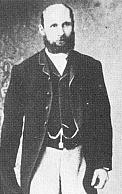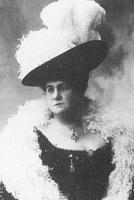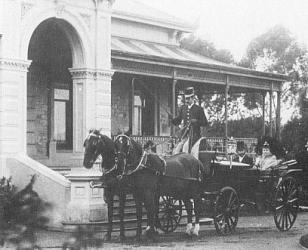![]()
'Charles Rasp'
 In
his application for naturalisation, Charles Rasp claimed to have been born at
Cannstatt (near Stuttgart) on the 7th October 1846. There is no record in the
register of births either at Stuttgart or at Cannstatt of a Charles Rasp, or
Carl/Karl Rasp/Raspe, around 1845-1846. The historian R Maja Sainisch has noted
that noone named Charles Rasp ever arrived in Sydney, Adelaide or Melbourne,
and suggested that the man known in Australia from at least May 1871 onwards
as Charles Rasp may have arrived at the port of Melbourne on the Peggy
on 8th February 1871 under the name "van Hengel". Mr "van Hengel"
is the only "unassisted foreign subject" (unassisted = paid for the
journey himself) listed as arriving in Australia between Christmas night 1870
and June 1871 (the period in which the man known as Charles Rasp is supposed
to have arrived in Australia).
In
his application for naturalisation, Charles Rasp claimed to have been born at
Cannstatt (near Stuttgart) on the 7th October 1846. There is no record in the
register of births either at Stuttgart or at Cannstatt of a Charles Rasp, or
Carl/Karl Rasp/Raspe, around 1845-1846. The historian R Maja Sainisch has noted
that noone named Charles Rasp ever arrived in Sydney, Adelaide or Melbourne,
and suggested that the man known in Australia from at least May 1871 onwards
as Charles Rasp may have arrived at the port of Melbourne on the Peggy
on 8th February 1871 under the name "van Hengel". Mr "van Hengel"
is the only "unassisted foreign subject" (unassisted = paid for the
journey himself) listed as arriving in Australia between Christmas night 1870
and June 1871 (the period in which the man known as Charles Rasp is supposed
to have arrived in Australia).
The real name of the man known as Charles Rasp was Hieronymus (Jerome) Salvator Lopez von Pereira. His grandfather was a member of the Portuguese aristocracy and a high-ranking politician. Jerome's father worked for a German prince in Portugal. The prince returned to Germany and Jerome's father went with him, and in Germany he married an aristocratic lady with whom he had three sons. Jerome was born in a castle in the kingdom of Saxony on 23rd November 1847. His parents died early (father 1854, mother by 1859), and at the age of 12 Jerome was sent to live with relatives in Paris, France which became his second homeland and where he received a good education. Jerome spoke four languages besides his native German: French, English, Russian & Portuguese.
In 1865 Jerome met and fell in love with the Countess Frieda Odkolek. The Countess's father did not approve of Jerome and his background and did not allow his daughter to marry Jerome, which apparently broke Jerome's heart. In December 1870 he was 23 years old and an officer in the Royal Saxon Army laying siege to Paris during the Franco-Prussian War. During the siege he met the Englishman Archibald Forbes, who was in December accompanying Jerome's regiment as war correspondent of the newspaper Daily News. Conditions on the front were terrible in the winter of 1870/71, and in his reports Forbes recorded that dozens of soldiers had frozen to death on sentry duty. Jerome heard about Australia from Forbes, who had spent time there in the 1860s. A close friend of Jerome, Dr. jur. Emanuel Raspe, was killed in action on 2nd December 1870. This event, plus his personal anguish about this war between his two homelands, plus the fact that his lungs were suffering from the winter conditions (he suffered a terrible cough for years after his arrival in Australia), were too much. Jerome disappeared from the battle and headed for Australia via a ship out of Holland. He later adopted his dead friend's name, Raspe.
Despite his good education, "Charles Rasp" left Melbourne immediately and spent the next few years picking grapes at Lilydale, goldmining in northern Victoria, working as a station hand in the Victorian/NSW border country, and tin mining at Jingellic in that same area. Rasp was familiar with "tin" country, as it had been mined in his local Erzgebirge area of Germany for more than 1000 years. He continued further north into New South Wales, working on various sheep stations and loading river boats on the Darling. He eventually ended up at Mt Gipps Station in the Barrier Ranges, where the manager George McCulloch employed him as a boundary rider.
On 5th September 1883 he pegged a claim to a block of about 40 acres on a hill with an unusual shape. The following day he and other workers on the Mount Gipps station, including the manager, went out and pegged claims to six more blocks in the same area. Rasp and the other six men formed the "Syndicate of Seven". The first shaft sunk on what became known as Broken Hill was named Rasp Shaft. In order to finance more work on the claim the seven agreed to split their shares in half and sell the resulting one-fourteenth share, provided they offered the one-fourteenth to other syndicate members first. Over time some members of the syndicate gambled away or sold parts of their share. Eventually, of the 14 members of the syndicate, Charles Rasp and George McCulloch, each holding three-fourteenths. The Broken Hill Proprietary Company was formed on 16th July 1885, though Rasp was not one of the directors, despite being one of the largest shareholders and the discoverer of the lode. The mine was the world's largest silver-lead-zinc mine, and BHP has become a global mineral resources company.
 The
money from his shares in Broken Hill allowed Rasp to go to Adelaide (Broken
Hill is closer to Adelaide than to Sydney) and start a comfortable social life
among the large community of German-Australians there. In 1886 he became a Justice
of the Peace in Adelaide and was a director of several companies. On 22nd July
1886 he married Agnes Maria Louise Klevesahl, who had arrived in Adelaide in
1882 on the Wodan from Hamburg. She was a blacksmith's daughter from
the Prussian village of Woldenberg. On board she had met Herrn Kindermann, who
had offered her a job as a waitress in his Cafe Kindermann in Rundle Street,
Adelaide. After their wedding they went to Broken Hill for a honeymoon, which
seems an unusual choice for that time. Back in Adelaide they moved into a large
mansion in Medindie called "Willyama" and led a life of luxury, entertaining
guests often at balls and dinner parties.
The
money from his shares in Broken Hill allowed Rasp to go to Adelaide (Broken
Hill is closer to Adelaide than to Sydney) and start a comfortable social life
among the large community of German-Australians there. In 1886 he became a Justice
of the Peace in Adelaide and was a director of several companies. On 22nd July
1886 he married Agnes Maria Louise Klevesahl, who had arrived in Adelaide in
1882 on the Wodan from Hamburg. She was a blacksmith's daughter from
the Prussian village of Woldenberg. On board she had met Herrn Kindermann, who
had offered her a job as a waitress in his Cafe Kindermann in Rundle Street,
Adelaide. After their wedding they went to Broken Hill for a honeymoon, which
seems an unusual choice for that time. Back in Adelaide they moved into a large
mansion in Medindie called "Willyama" and led a life of luxury, entertaining
guests often at balls and dinner parties.
Rasp, Agnes, her maid Anna Paech and Agnes's half sisters travelled widely together, and in 1900-1902 they went to Europe, and during this tour twice visited the Niederwald National Monument near Frankfurt, built in 1871 to honour the dead of the Franco-Prussian War. They met Baron Fieldmarshall Richard von und zu Eisenstein in the fashionable resort town of Karlsbad, Bohemia. He later visited them in Adelaide in 1903.
Rasp was very fond of the 14 year-old daughter of his solicitor and on 9th February 1905 he wrote in her poetry album:
An album is...
A list of living friends: a holier room
For names of some since mouldering in the tomb
Whose blooming memories life's cold laws survive,
And, dead elsewhere, they here yet speak and live.
Not a particularly cheery set of lines for a teenage girl perhaps, but was he referring to himself?, allowing his friend Dr Emanuel Raspe, dead elsewhere, to speak and live on here?

Agnes and Charles Rasp in font of their villa "Willyama", Adelaide
On 22nd May 1907 Rasp died suddenly at home from a heart attack. On a trip to Europe after Charles's death, Agnes became engaged to the almost 70-year-old Baron Richard von und zu Eisenstein, but he died of a heart attack in a London hotel the day before the wedding. Agnes married Count von Zedtwitz in London in April 1914. When World War One broke out, the Count and Countess von Zedtwitz stayed in Berlin until the war was over. The Count died at the end of the war, and the former Agnes Rasp returned to Adelaide in 1920, where she died childless in 1936 at the age of 79.
Charles Rasp did not reveal his true identity to anyone.
Summarised from:
Hawkins, John. 1997. "Charles Rasp and the
model of the Broken Hill Mine". Antipodes Antiques & Fine Art, Antipodes
1, pp42-55. Antipodes Publications, Victoria.
The Line of Lode Association. Charles Rasp.
(source unknown)
Sainisch, R. Maja. 1984. "Charles Rasp: a
born gentleman". In Journal and Proceedings (Broken Hill Historical
Society), Vol. 20, December 1984, pp. 81–91.
See also:
Sainisch-Plimer, R.M. 1999. "The Life and Times of Charles Rasp", in Minerals of Broken Hill, (W.D.Birch, Ed., Broken Hill City Council), pp. 12-33.
| Top | Back
| Chronology | Issues
| Students | Site Map |
auf Deutsch |
| Primary Sources (in German) | Bibliography
| Search |
German Australia © D. Nutting 2001